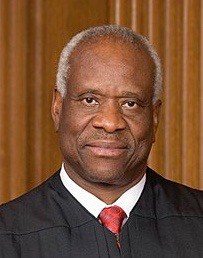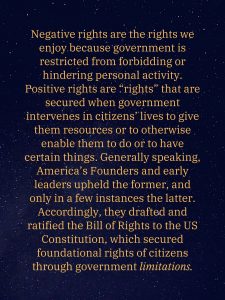An Essential Step in Preserving Authentic Liberty and Natural Marriage in the United States
Properly understood, rights are not guarantees that something will be provided for us but guarantees that what is ours will not be unjustly taken from us.
—Calvin Beisner—
The Constitution was made to guard the people against the dangers of good intentions.
—Daniel Webster—
Key point: Only God-given, unalienable rights are compatible with liberty and authentic freedom.
Access summaries and links to all the articles in this series here.
Last time we began discussing the matter of rights. Specifically, we began examining the difference between the perspective on rights held by America’s Founders and the perspective on rights most Americans hold today.

We looked at FDR’s “Four Freedoms” Speech. The first two freedoms he named—freedom of speech and freedom of worship (and other freedoms like them), are God-given and unalienable. These freedoms or rights are secured and preserved when government recognizes and maintains them, and when it stays out of the way and lets citizens act as they see fit, according to the dictates of their desires, convictions, and consciences. Because these are prerogatives that the state didn’t create but has a responsibility to affirm and protect, they are called negative rights.

The last two freedoms or “rights” President Roosevelt named in his speech are freedom from want and freedom from fear. These and other such “rights” are are called positive rights. They’re qualitatively different from the first two, because to establish and maintain them, government must intervene into private affairs, manipulating and arranging everything deemed necessary to usher them into the national way of life.1 In the process, a great many negative, innate rights are ignored and violated.
Here is a summary of what we’ve said with some important additional information. You can pull it onto your desktop for quick reference.
Negative rights are the rights we enjoy because government is restricted from forbidding or hindering personal activity. Positive rights are “rights” that are secured when government intervenes in citizens’ lives to give them resources or to otherwise enable them to do or to have certain things. Generally speaking, America’s Founders and early leaders upheld the former, and in only a few instances the latter (such as a right to a trial by jury). Accordingly, they drafted and ratified the Bill of Rights to the US Constitution, which secured foundational rights of citizens through government limitations.
Our Founders saw freedoms and liberties in terms of negative rights; but today, Americans think of their freedoms almost exclusively in terms of positive rights. In other words, we’ve drifted far away from the ideal that the Founders upheld.

When accepted and affirmed nationally, the Founding Fathers’ understanding of rights leads to liberty and true freedom on a multitude of levels. The modern view of rights—again, the one held by most Americans today—is fertile ground for tyranny and totalitarianism. As Ronald Reagan declared, “[M]an is not free unless government is limited. There’s a clear cause and effect here that is as neat and predictable as a law of physics: As government expands, liberty contracts.”
Man is not free unless government is limited. There’s a clear cause and effect here that is as neat and predictable as a law of physics: As government expands, liberty contracts.
—Ronald Reagan—
Where the Rubber Hits the Road
Some make a distinction between negative and positive rights and negative and positive liberties, but for our purposes here, we will use these terms interchangeably. Writing at libertarianism.org,2 Aaron Ross Powell explains,
If we want to start very simple, keeping our definitions to just two words each, negative liberty means “freedom from,” while positive liberty means “capacity to.”
Another way of thinking about the difference—though again, it’s a rough one—is to see negative liberty as being about the absence of external limits, while positive liberty is about the absence of internal limits.
As we will see, this isn’t merely theoretical or academic, but extremely practical. It’s very much about our own day-to-day lives. This is where the rubber hits the road.
Powell goes on to offer an example with two scenarios. We summarize his presentation as follows.
Scenario one: Evan has family members in Nebraska and wants to visit them. He lives in Pennsylvania, so he has to travel hundreds of miles to make the desired visit. Seen from the perspective of negative rights, Evan has a right to make the trip, and he is free to make it if he has the time, resources, and other means. It’s important that no one hinder him, or that if anyone tries he or she is held accountable.
What if someone does try to keep Evan away from his family? Let’s say a guy comes along and kidnaps him or steals his car. Describing these situations, we would be correct in saying Evan’s negative right to travel to Nebraska has been violated. However, if in these ways or in others no one keeps our Pennsylvania friend off the road, Evan’s right to journey to the Cornhusker State will not have been thwarted—even if in the end he chooses not to go.
Scenario two: Suppose, though, that Evan lives in poverty and can’t afford to make the long journey. Or perhaps he has a bad back and can’t endure the rigors of travel for a long time. No one is hindering him from going to see his family, so his negative right to travel isn’t being derailed. Even so, describing the situation from a positive rights standpoint, someone would say Evan’s “right” to visit his family members has been undermined because he lacks what he needs to go to Nebraska. Advocates of Evan’s positive right to travel would make the case his ability to journey westward should be secured.
Assuming the state sees Evan’s trip as a right, what might it do? We do not have to guess. It will tax and redistribute resources to make it possible for Evan to visit his family! Even though in this situation we can say that taxpayers’ rights have been violated because they are being forced to pay for a trip for someone they never have met, as well as a trip that brings no measurable benefit to the public at large, in the end these facts don’t matter. Why? Because a positive-rights perspective tends to focus exclusively on the meeting of positive rights, through whatever means.
A positive-rights perspective tends to focus exclusively on the meeting of positive rights, through whatever means.
Keep in mind that with such rights, we aren’t speaking only of Evan, but of countless others as well; and while we probably aren’t talking about excursions to Nebraska, Evan’s trip helps us begin to understand the impact that positive rights can and do have on others.
Opportunities and Outcomes
Consider this as well. Advocates of negative rights affirm opportunities for all rather than the equal outcomes sought by proponents of positive rights. Take note! Opportunities in the context of negative rights are not identical, but they are equal in that people are equally unhindered by the government from fulfilling their desires and reaching their potential. Only in the context of positive “rights” are opportunities manipulated or engineered by government to “level the playing field.”
Let’s put it another way. The modern American view of rights upholds positive rights, which essentially are rights that rely, not on natural opportunities that need to be protected, but on outcomes and opportunities the government must engineer. As the people’s appetite for positive rights increases in an otherwise free country, and as citizens demand more from the state, the nation moves—gradually, slowly—from liberty to tyranny.
The modern American view of rights upholds positive rights, which essentially are rights that rely, not on opportunities that need to be protected, but on outcomes and opportunities the government must engineer. As the people’s appetite for positive rights increases in an otherwise free country, and as citizens demand more from the state, the nation moves—gradually, slowly—from liberty to tyranny.
Same-Sex “Marriage”: A “Right” Inconsistent with the Founders’ View of Liberty and Rights
Thus far we’ve spoken of positive rights in terms of the wealth and other material resources government must use to create those “rights” and bestow them on the individuals and groups demanding them. Some “rights,” however, have been created through manipulation of another kind, even though material resources have been involved.3
The Supreme Court of the United States has issued some egregious rulings in the past, including Roe v. Wade and Doe v. Bolton, which legalized abortion on demand in all 50 states. These and several other SCOTUS opinions notwithstanding, I believe the most blatant example of a ruling violating negative, inherent, unalienable, God-given rights in the history of the United States has been Obergefell v. Hodges, the SCOTUS decision that effectively (and unconstitutionally) redefined marriage to include same-sex couples. No other decision stands so defiantly against “the Laws of Nature and of Nature’s God,” or against the ideal of rights as envisioned and upheld by America’s Founders.

Supreme Court Justice Clarence Thomas understands these realities as do few others. In his dissent in Obergefell, he made many vital and important points, including these three.
-
-
- A “right” to same-sex “marriage” is unnatural and outside the realm of rights the Founders of America recognized. (Notice Thomas’s point here is that a right to same-sex marriage is unnatural. It is not God-given, inherent, unalienable, or readily recognizable as a right.)
- Second, those demanding recognition of same-sex relationships as marriage never had any of their inherent rights violated. They demand a “correction” where no true harm ever was imposed on them.
- Granting a right to same-sex “marriage” sets the stage for the natural, inherent rights of others to be thoroughly disregarded.
-
Next time, we’ll consider each one of these, one at a time.
It’s a discussion you absolutely won’t want to miss!
Part 3 is available here.
Copyright © 2019 by B. Nathaniel Sullivan. All rights reserved.
The content of this post has been adapted from articles in the series “Misinformed and Misled: How a Distorted Perspective on Rights Is Leading America into Tyranny.”
Notes:
1This insight was developing in my mind when I first heard Chuck Colson express it and explain it. I have searched extensively for the source in which he wrote or spoke about this but have been unable to locate it.
2The citing of the libertarianism.org should not be construed as endorsement of every tenet of libertarianism or of everything found on this website.
3Initially, through Roe v. Wade and Doe v. Bolton in 1973, the Supreme Court carved out a “right to privacy” and a “right to abortion” where neither of these exists in the Constitution. That certainly is horrific enough, but today we are being told the “right to abortion” means taxpayer-funded abortion in the name of “women’s health.” Clearly, the positive “right” to abortion is trampling on the negative rights of taxpayers to use their own hard-earned money in ways they themselves see fit. Of course, this doesn’t even take into account the cost (economic and otherwise) society still is bearing because of the countless millions of “missing persons scenarios” abortion has created since its counterfeit legalization nationwide in 1973. With so many consumers and producers unable to fill their God-given tasks, the negative economic impact on the country has been colossal.
image credit: Monument at Four Freedoms Park in New York
image credit: Four Freedoms Park


Be First to Comment